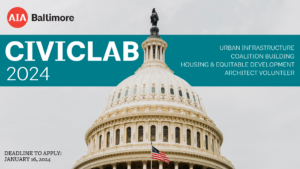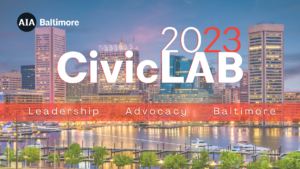Making AIA 2025 National Conference Attainable
By Griffin Sanderoff, NOMA, Assoc. AIA
Attending the AIA Conference on Architecture & Design 2025 in Boston was profoundly inspiring & I want emerging professionals to see the experience for how achievable and in-reach it may be for them.
I’m lucky to be deeply involved in our local design community, serving in leadership roles with AIA Baltimore, the Baltimore Architecture Foundation, and AIA Maryland. That work motivates me to seek out new conversations, tools, and ways of thinking about the future of neighborhoods and cities. So when the opportunity came to attend the 2025 National Conference, I wanted in but had financial hurdles.
Thanks to the combined support of AIA Maryland and AIA Baltimore, I received full sponsorship for the $900 conference registration. I also signed up for AIA National’s volunteer program of “if you work an eight-hour shift, your registration gets fully refunded.” That meant the sponsorship could instead cover my travel and housing. Next, I asked my firm, BCT Design Group, if they’d support the trip by giving me paid time off without using my personal PTO to which they said yes. That level of support – from both AIA and my firm – to my professional development made this entire trip possible.
I stayed in a modest Airbnb and chose connecting flights to minimize costs, arriving early to settle in. Despite the lack of luxury, I was beyond content as I constantly marveled at Bostonians of all ages, professions, and backgrounds sharing the same transportation infrastructure. It really was beautiful to witness a transit system doing exactly what it’s meant to: connecting people with dignity and ease. These logistical choices not only made my attendance possible, but they also set the stage for deeply absorbing the meaningful conversations that followed.
One of the most affecting moments was hearing 2025 NOMA President Bryan Lee Jr. speak. His message wasn’t easy or comfortable, but it was clear: injustice has been designed into the built environment and it’s our responsibility to design differently. Not as performance, but as an ethic embedded from day one. His seminar’s message stuck with me and not because it was brand new, but because it was said so clearly and with no space left for detachment.
This theme echoed throughout the week. Whether it was Pete Buttigieg talking about infrastructure as equity, or Allie K. Miller reframing AI as a creative co-pilot, or Dami Lee reminding us that humor and storytelling are part of what makes design
accessible, there was a shared energy. That design is a public act. That we’re not just shaping buildings, we’re shaping how people live for years and years to come.
There wasn’t one defining moment for me in Boston, but I left with a clearer perspective. The people I met, the work I saw, the conversations I had, they reminded me that I’m part of a much larger community. A community of people who aren’t just pushing out projects but shaping environments with real intention.
Translating these ideas into everyday practice is crucial and this work requires showing up, whether that’s in your neighborhood, on a board, at a public meeting, or at a national conference. It’s okay not to have all the answers, but it’s not okay to stop asking better questions.
So, if you’re an emerging professional wondering if this kind of experience is for you, whether you can afford to try, whether you’ll belong: you can and you do. With support, resourcefulness, and maybe a transit pass, this kind of opportunity isn’t reserved for a select few.
I hope that more people like me – deeply invested in their communities, still early in their careers – will find a way to get there. Because the profession is much, much better when you’re in the room.


